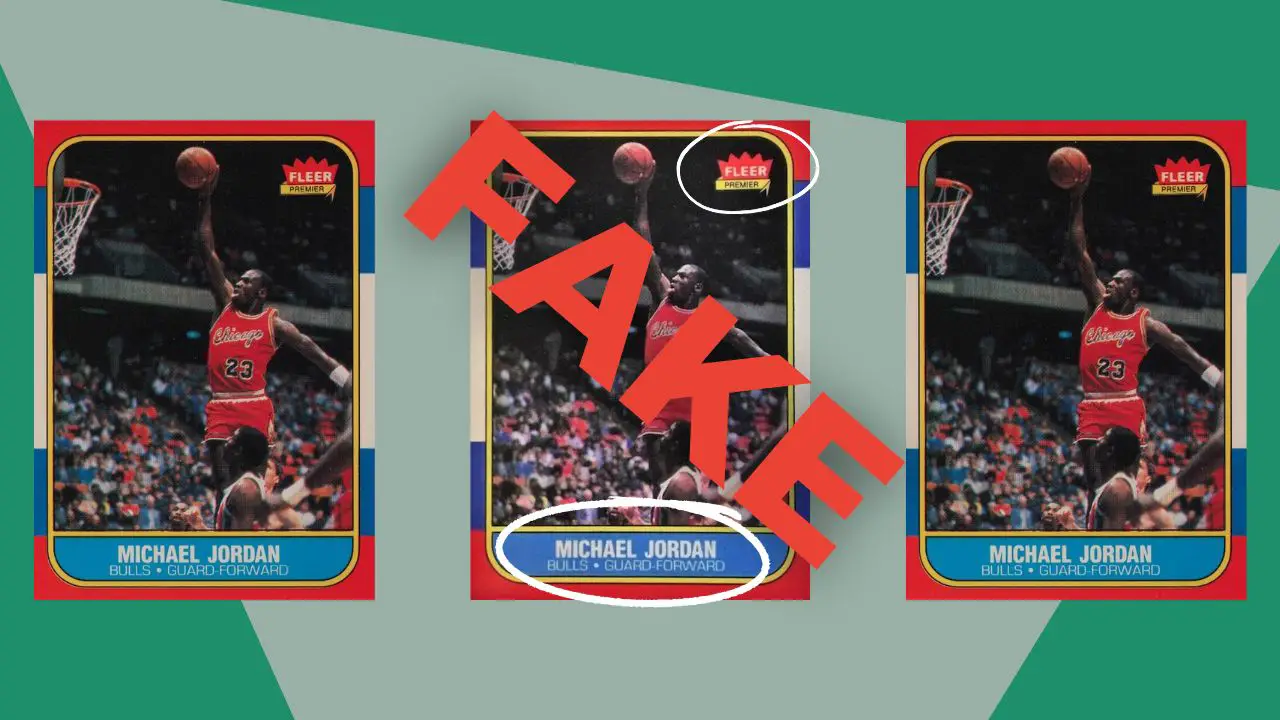
The printing of fake sports cards has improved over time, and some are hard to spot, so it’s important for any collector to know the red flags and the signs to look out for when spotting a fake card.
The guide below goes through the signs to help spot counterfeit cards, and the steps to take to avoid buying counterfeit sports cards.
Table of Contents
Quick Summary
Before I go into the full guide, here’s a quick overview:
- If you can, physically inspect the card with a magnifier and black light and look for inconsistencies; Ideally, you've got an authenticated copy to compare against.
- If you're buying online and can't inspect the card physically, make sure you have enough clear images, and you're buying from a trusted marketplace and source (look at seller's previous feedback).
- You should assess brand logos, copyright and printing information, the card stock and finish, printing quality, signs of artificial aging, and card layout.
- Scammers target high-value cards, which are highly sought-after.
Now let’s go into more detail, with tips, advice and recommended resources for help spotting fake sports cards:
How To Tell If A Sports Card Is Fake
Firstly, it’s important to remember that if something seems too good to be true, it probably is.
If you’re in the market for a sports card, and you come across a deal that seems a bit too good, as the buyer, it’s the first big red flag that it could be a counterfeit.
It’s common for scammers to make their fake card seem like a great deal, with a heavily discounted price, so they can shift it quickly; The sense of urgency to get the card at the great price can also make a buyer less thorough when checking its legitimacy.
It doesn’t take long to check the approximate value of a card, and in my experience, most sellers these days know the value of what they have, so it’s unlikely a real card will be advertised at a huge discount from what it’s usually worth, unless it’s fake.
However, that’s only one sign collectors should look out for, not every fake sports card will be advertised at a low price.
A good deal of scammers realize it’s a red flag, so they sell for a price you’d expect to see a real version sell for, to avoid raising suspicion.
So, regardless of whether the price is a favorable deal or not, there are other signs you should look for to spot a counterfeit sports card:
Physically Inspecting a Card
If you have the chance to physically inspect a sports card in person, there are multiple things to look out for to check its authenticity.
The printing quality of fake cards has improved over time, and some are hard to spot, so I’d recommend the following tools, to help inspect a card properly:
There’s also a book, by Ryan Nolan, that I’d recommend reading, titled ‘Spotting Fakes: Examining the Top 50 Fake Sports Cards’ – It’s full of tips for spotting fake cards, and it’s something I’ve used to help get better at authenticating cards.
Now let’s discuss what you need to look for.
Again, having a known authentic version to compare against is the ideal situation, but often not possible; However, you can search for a high-quality image online to compare against, or a cheaper, more available card from the same set.
Auction sites which have brokered sales of top sports cards in the past, like Goldin and Heritage for example, take clear and high-quality images of cards, both front and back, to appear on their website listings, and remain in their database after an auction has ended, so they can be accessed with a quick search – I’d use these if I didn’t have access to a physical version.
Logo and Branding Elements
A good place to start is by inspecting the manufacturer’s logo and any other brand elements. Authentic cards usually have precise and consistent placement and coloration, whereas counterfeit cards often have less sharp brand logos, with signs of ink-bleeding in some cases.
Copyright and Printing Information
Verify any copyright dates and manufacturer details on the card.
Authentic cards typically feature legitimate printing marks, and even watermarks in some cases, a black light can help spot those.
Card Stock, Finish and Size
This one is only really possible if you have an authentic card from the same set to compare against.
You can check the card stock and finish on the card, that’s being inspected, is as it should be, with the same quality and feel as the authentic cards.
A black light will also come in handy when inspecting sports cards that are supposed to have been printed pre-1940.
Take them into a dark room and use the light on the surface, if the card glows then it’s likely a counterfeit.
Manufacturers began using optical brighteners in products, which made them appear brighter, and they glow under a black light; Legit cards from pre-1940 should not glow.
Size is another one, is the card the size it should be? Measure the dimensions and check against authentic cards that are from the same set.
Printing Techniques and Quality
Fake sports cards, that are forgeries of old cards, usually have visible printing dots on the surface, which are more easily detected with a magnifier.
Half-toning is often used in modern printing, which produces a dotted pattern, so while it won’t help you spot a fake modern card, it will help with old and vintage cards, because they wouldn’t have been printed with half-toning, and therefore shouldn’t have the dotting.
Something to check for both old and modern cards is the quality and clarity of the images – Again, it’s one that’s easier if you have another to compare against.
Text and borders are also not usually as sharp on counterfeit sports cards.
Artificial Aging
Another one for cards that are supposed to be older; Look out for any signs of artificial aging to a card, which is often done by soaking them in tea or coffee.
Upon drying, it gives the card a worn look, but also a lined pattern which is the giveaway, if you know what you’re looking for.
Forced wear and tear is a tactic used by scammers to pass off counterfeit cards as genuine, so look for unnatural wear patterns.
Card Back Layout
Don’t just check the front of a card, inspect the back to make sure it looks like it should, even if you’re comparing against an image, you can look for any irregularities.
Example
Here’s an example of an authentic 1986 Fleer Michael Jordan rookie card, which is one of the most commonly counterfeited cards, alongside a fake version.
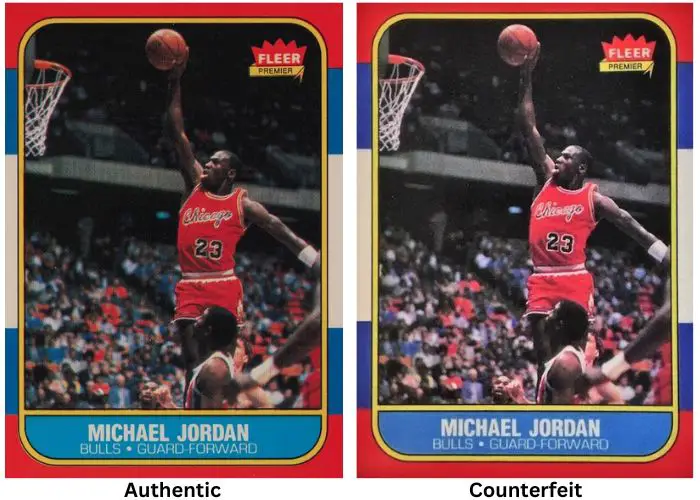
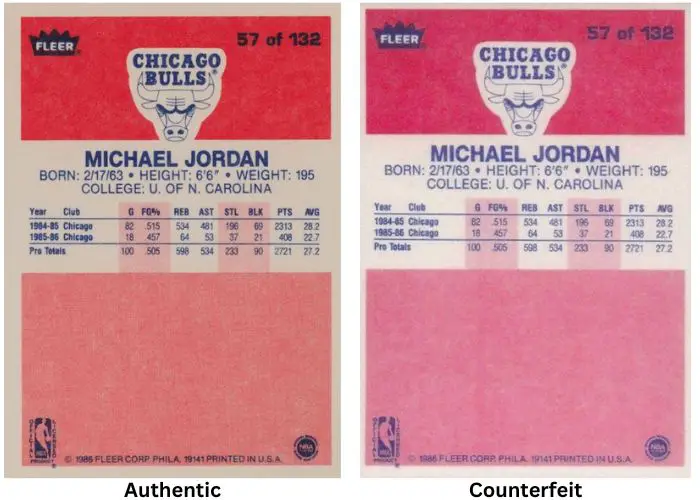
A quick glance from an untrained eye will probably struggle to see any major signs of a fake card, but I’ve highlighted some of the giveaways below, and evidence of the checks that I’ve listed above.
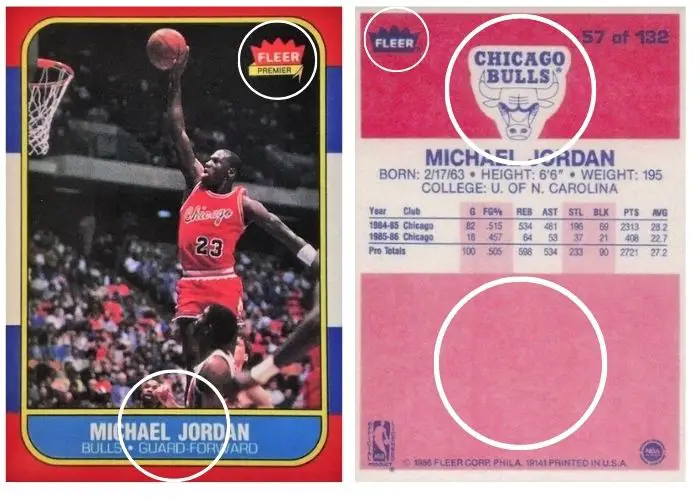
- Firstly, the brand elements that have been circled on the fake card, like the Fleer logo – You can see on the authentic card, the brand logos are sharper, compared to the counterfeit which has a slight blur to it; There’s also a slight difference in coloring.
- The Chicago Bulls logo, circled on the back, is also not as sharp on the counterfeit card as it is on the authentic version, and again there’s a slight difference in color.
- The name, team and position text on the front of the authentic Jordan card is a lot clearer and defined than it is on the fake – The white of the text bleeds into the blue background, whereas it’s more defined on the real card.
- Finally, you can see a clear difference in the texture of the solid red color on the back of the cards.
They might seem like subtle differences, but they’re clear signs of a fake to someone who knows what they’re looking for. The example above also shows the benefit of comparing to one that you know is authentic.
What To Do If You Can't Inspect A Card Physically
Most scammers won’t give you the chance to physically check their cards for the signs and red flags that will give away their counterfeit – Most will be advertised for sale online, through sites like eBay or Facebook marketplace.
If you’re buying a trading card online, there should be at least one image of the card, but that probably won’t give you much to inspect for a forgery.
You can take a look and see if there’s any obvious inconsistencies with how an authentic version should look, but scammers aren’t likely to give a high-quality image, that is a red flag in itself to look for.
So, there are other ways to protect yourself when buying online, without the ability to physically check a card before buying:
Ask For More Images
If the images that are provided on a listing are low-quality, there’s no reason a seller shouldn’t be willing to provide more, if you ask.
If they say no to the request, then there’s a good chance it’s because they’re trying to scam you, I would personally avoid buying a card in that situation.
If you have access to multiple images, you can perform a digital inspection to look for the signs I’ve mentioned above.
Seller History
Auction sites, like eBay, should have information about the seller, and their history – It’s a good idea to check them out, and see the feedback others have left them.
If a new profile, with no previous sales or feedback, is selling an expensive and rare sports card, be cautious, although it isn’t necessarily a confirmed scammer, it’s definitely a red flag.
If a seller does have previous feedback from other buyers that is negative, and suggests they list fake cards, you should obviously avoid buying from them.
You should also check the listing description, if a seller is pleading ignorance by saying they aren’t sure if it’s a real and original version of the card, then that’s a huge sign that it could be a scam, and I would recommend not buying.
Buy From Trusted Websites
Specialized sports collectible auction houses, like Goldin and Heritage, are about as safe as it gets when buying sports cards online.
Those companies will have their own authentication process for high-value and rare cards, which are the target for most fakes, so if you’re buying via one of these, the checks and due diligence will have already been done.
That’s not to say that some don’t fall through the cracks now and again, but the trusted auction sites have been known to refund customers for fake cards in the past, in the worst case scenario.
eBay is another site which sees a high percentage of online card sales, and while you’ll need to look out for the signs of a counterfeit card before buying, if you do receive a fake, eBay’s counterfeit policy protects you from losing your money.
eBay does also have their Authenticity Guarantee for qualifying collectible cards, where the seller ships the card to their facility for authentication before it’s sent on to the buyer; eBay partners with CGC and PSA to help with authentication. If a card cannot be confirmed as legit, the sale is cancelled.
Buying from websites like Facebook marketplace is more risky, because you haven’t got any protection if you purchase a counterfeit – I’d avoid buying high-value cards from sites like this, it’s unlikely authentic rare and high-value sports cards would be sold on these platforms.
Seek A Second Opinion
The internet has made the world a much smaller place, and the hobby is more connected than it’s ever been.
It’s quite easy to get in touch with other collectors online through forums etc, so if there’s an online listing you’re not sure about, it might be a good idea to reach out to others for a second opinion.
There are experts out there, with plenty of experience, that can help spot the signs of a counterfeit.
Graded Cards
Buying a graded version of a sports card is always safer than buying raw.
Top grading companies will check the cards, that they are grading, are authentic, before putting them in a slab, so it’s best to go with the most established and trusted grading companies, like PSA, SGC and Beckett, if you want to be safe.
You can check the certification number of a graded slab to check it’s legitimately from the grading company.
However, it’s not a sure thing, scammers have been known to remove authentic cards from a graded slab and replace with a counterfeit; The top grading companies make it very hard to do that without breaking the slab, so look for any signs of tampering.
The Most Counterfeited Sports Cards
Counterfeiters generally target the most valuable and sought-after sports cards, because they command big money, and they’re not usually readily available.
Cards that are commonly counterfeited include:
1909 T206 Honus Wagner
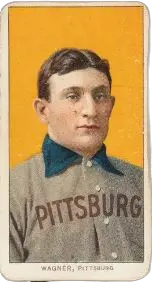
1933 Goudey Babe Ruth #144
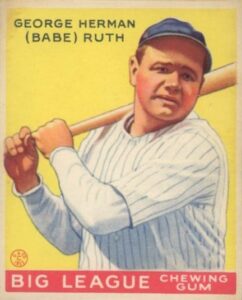
1952 Topps Mickey Mantle #311
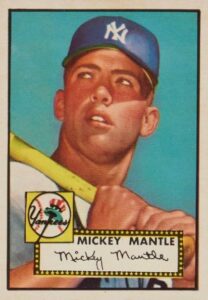
1979 O-Pee-Chee Wayne Gretzky #18
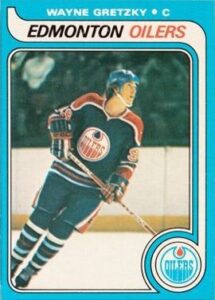
1986 Fleer Michael Jordan #57
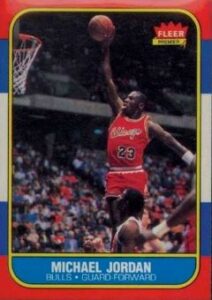
The Difference Between Reprints And Counterfeits
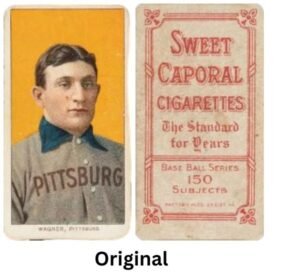
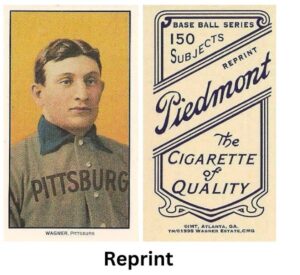
On the topic of counterfeit cards, it’s important to mention reprints, which can be confused with fakes.
Distinguishing between reprints and counterfeit cards is crucial, because they aren’t the same thing.
Reprints are exactly as they sound, they’re a reprinted version of an older card, created as their own type of collector’s item, which acknowledges that they’re a reproduction (They often have the word ‘reprint’ or ‘reproduction’ on the card itself).
They offer collectors the chance to own something that represents the original, which might be too rare or too expensive for someone to buy, as the next best thing.
Reprinted cards are sold at a fraction of the price of their original genuine counterparts, because sellers do not intend to mislead buyers into thinking they’re buying an authentic original, and a reprint won’t hold anywhere near the same value as the originals.
They are advertised as reprints, whereas counterfeits are cards that have been created to be falsely passed off as an original.
Scammers do list reprint cards on sites like eBay and advertise them as an original – Reprints are usually easy to tell apart from originals, so make sure you make the relevant checks before buying.
A Background To Fake Sports Cards
Online marketplaces and auctions have made buying and selling sports cards easier than ever, and the hobby continues to see lots of interest, with huge amounts of money spent on cards every year.
Collectors are willing to pay hundreds of thousands, even millions of dollars for the most desired and valuable sports cards of all time.
However, a market that attracts so much interest and money, also attracts scam artists and counterfeiters, who look to exploit the wealth associated with it, and that’s no different for the sports card market.
Fake sports cards have become more common as the hobby has grown; It’s the dark side of a hobby that is meant to be about passion and nostalgia.
Counterfeit sports cards go back decades, with fake baseball cards dating back to the early 1980s, but now it’s not just baseball cards, we see all types of sports cards targeted.
Scammers tend to target the most valuable and sought-after cards, both modern and vintage, as they look to take advantage of their value and rarity.
We’ve seen some high-profile stories of scammers making hundreds of thousands by selling forgeries, like Mayo Gilbert McNeil, who made $800k selling fake 1986 Fleer Michael Jordan rookie cards.


One Comment
From BC. Canada looking for information on getting some of my cards graded, where to send and costs, if you can help me with this, Thank You